India StoriesIndia has many stories. Here are a few short essays telling some of the things we have seen as we have wondered the country. Many stories are new and unique to this page. Some of have appeared on our India blog and are here to give them a more permanent home. Cars and roads - A new keyboard - One hundred five-rupee coins - No Parking - Taxis - Getting connected - Vendors are people too - Twenty five Ganeshas - Vipassana - Ant dam - Mantras, calls, and chants - Mistakes - Be detached - A day in Varanasi - Private space - Auroville - India index. Cars and roadsWhen we first arrived in India in 2004 the cars on the street were locally made Tatas and Fiats. These smaller cars shared the road with a tank of a car, the Ambassador. The first time I saw the latter, I thought it was made in the forties. It had all the looks of the forties: beetle shape, large size, bulky body, and '40s instrumentation. Then I found out the one I was looking at was made in the late '90s. They had been and were still making it the same way for many years. It was a workhorse.
Then we returned in 2011 and now again in 2013. The roads are more or less the same. There are a couple new expressways in Mumbai; but they are so poorly made that one can safely travel little more than 40 miles an hour (65 kilometers an hour). Traffic, like earlier, was literally anything that you can think of that moves—trucks, cars, mopeds, motorcycles, bicycles, busses, rickshaws, ox carts, people, dogs, and cows, especially cows who are sacred in India. The back of every truck says, “Honk horn” or “Sound horn.” Everyone does, not only for trucks, but also for almost anything they pass. The Indian road is noisy. Driving on any road is like navigating a stream flowing down a mountain. You have to learn to see the flow and then go with it. One time in 2004, I took a rickshaw (a three-wheeled motorcycle taxi just bigger than a moped) ten kilometers (6 miles) from Auroville to Pondicherry. I was in a hurry for some reason and told the driver so. He dogged and darted through the traffic as if he were Mario Andretti in a Formula I race. We passed cars, trucks, and busses with less than an inch between us. We arrived wherever it was I was going on time—and in one piece. The Delhi-Calcutta highway goes through Varanasi. The Indians are proud of it, It’s one of their premier highways. You cannot go faster than 60 mph (100 kpm) on this four-lane highway, not because there are too many ox carts, trucks, busses, or bicycles on it, which there are, but because the surface will not let you go faster.
No matter where you are going or what road you are on, 20 to 24 mph (30 to 35 kph) is the average speed you are going to make when driving any distance through the countryside. The roads, the traffic, the people are all going to conspire against you preventing any faster movement. That means that even in a ten-hour day you cannot expect to go farther than 200 miles (320 kilometers). While the highways, roads, and streets are essentially in the same or poorer condition in 2014 than they were in 2004, the amount and type of cars has changed drastically. Now all the cars of the world are here. Kia, Honda, Toyota, Subaru, BMW, BSA, Chevrolet, Ford, and others are here in abundance out shadowing the old Ambassadors, which are still out there. All these new, much bigger cars are cramming onto the same infrastructure that was there eleven years ago. Traffic is heavy. A friend in Mumbai, a lawyer, bought a big BMW sporty model. He says, “I am going to have to buy a small car to put in the trunk of the BMW so I can more easily get around the streets of Mumbai.” I do have to say that the BMW rides more smoothly than a rickshaw or Toyota on a rough and potholed highway. Early in 2014, we got an invitation to ride in a large Toyota Innova from Gorakhpur to Varanasi one day, a distance of around 125 miles (200 kilometers). We had made the same route on a fast train in four hours; the normal train is six hours (20 to 30 mph – 32 to 48 kph). Even in that big car, the ride was rough. This was on the main road between two large cities in northern India. The road was littered with potholes. We literally had to drive from side to side to avoid the larger ones. It was worse than a farm path at times, an agony that took better than six hours, 20 mph (32 kph). Busses and trucks rule the road. They are big enough to take the path they want. Often a bus going down a narrow road rides dead center of the road. That is because it is often crowned and very often the smoothest there. It seems as though the drivers like to play chicken. They keep to the center as whatever traffic approaches. It in only at the very last second that both vehicles swerve to their left to avoid a collision. The first few times you experience it, you can be taken aback. But after a while it gets to be business as usual and you pay little attention. A new keyboardWe were in northern India in the somewhat remote Kushinagar, the place where Buddha made his first public speech after his enlightenment. The letter “g” broke on the keyboard of my laptop. Where was I going to repair it? We walked across the street from our home base at a Tibetan temple to a phone kiosk. The clerk told us, “There’s a computer store in the next town.” An hour and two rickshaw rides later we were in the bustling next town to the east. Here the rickshaws were man-powered. Our driver stopped at several places asking if they could repair computers. He was more patient than we were, even thought there was nothing we could do. Eventually, we found a computer shop—he couldn’t fix it but he could get a keyboard from the next city. It would take “two hours.” I was skeptical but, ”OK, make it happen.” In the meantime, he showed me how the Windows accessory onscreen keyboard works and told us to come back in a couple hours at 3:30. We wandered the shops looking for what we didn’t think we needed. I bought a watch that I did need. When we arrived back in the shop, there was still no keyboard. “It’s coming.” He made some calls. “It’s on a bus and will be here in an hour.” We sat around. Four thirty came and the keyboard didn’t. This time the results of the phone call were, “It’ll be here in half an hour.” “We do not want to wait longer. What can you do now?” “We will bring it to where you are and install it.” More skeptical, we told them where we were staying and gave them our telephone number. All this time our rickshaw driver has been waiting around patiently. He pedaled us back to the place we were staying. We paid him, gave him a good tip, and thanked him for all he did for us. Just pedaling us six kilometers in the heat was a major task as far as I was concerned. As we paid him, another rickshaw driver we had used earlier came up. He was the father of the one who worked so hard for us that day. The afternoon moved into evening and dinnertime and still no call from the computer shop. We decided to go eat. In the middle of dinner, the phone rang. It was our repairman. We told him where were. Shortly he and a colleague drove up on their motorcycle. They came in and proceeded to change the keyboard on the end of our dining table in the restaurant. In ten minutes, the “g” was working again and all were happy. I had my “g”—and still have it months later—and they had their 1000 rupees ($16.30). [I think the labor alone would be far more than $16.30 in the US.] One hundred five-rupee coinsWhen we arrived in Mumbai the first time in 2004, young kid beggars besieged us. Every time we ventured onto the market we could hardly move without one or two kids tugging at us begging for money, food, and milk powder. The first two are understandable, but milk powder? What was that about? They want it for their “baby sister or brother” at home. It seems there are gangs of beggars using this new scam to wrench a bit more out of unsuspecting foreigners. They are in league with storeowners so even if you demand to buy the milk yourself, they take you to their store. You give money to the owner. The owner hands a package of milk to the kid, and you leave. After you leave the kid gives the milk back, gets a small percentage of the “cost” back, and goes back on the street to seek the next “donation.”
Petra came on the idea of five-rupee coins. Get five-rupee coins and give each kid one or two when they approach us. That would not be so much that we would be supporting the gangs (the kid might even be able to keep it). And there would be a little positive energy entering the world. Now, where do we get a supply of five-rupee coins to support our plan? We went to several stores to no avail. Then a street person heard our request to a shop owner. When we came out, he said he knew a shop owner who could supply the coins. We went down the street and into a shop. “Yes, I can give you five-rupee coins for your 500-rupee note.” He proceeded to count out the coins, put them in a bag, and hand them over to me. I took them out and counted them. There were only 400 rupees. “Where are the other one hundred rupees?” “That is the cost of giving you the change.” “I want 500.” “I only give you 400, the rest is for my work.” I pushed them back across the counter and we left. Just down the street, there was a bank. Someone had given me the impression that the bank would not give such change. I decided to try. In five minutes, we walked out with a hundred five-rupee coins in my pocket. I gave Petra a hand full and we continued on our morning walk. The first kid was happy with our donation to his cause. So was the second and the third. Then along came a girl asking for milk-powder money. She took the five rupees but asked again for milk-powder money. After several more attempts, she gave up. We gave out five and ten rupees the next few days. Then the number of beggars seemed to slack off. There were fewer and fewer with each passing day. We began to recognize the few that persisted. Maybe they were the genuine ones. The gangsters had given up on us. It felt good keeping things positive though small. In the end, there were smiles for us and for the kids as we walked down the street and saw each other. When we left Mumbai, we still had five-rupee coins in our pockets. 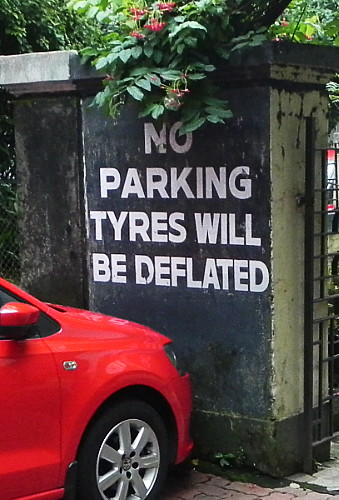
No ParkingOne day as we were walking around Mumbai getting a feel for our new surroundings, I read this sign at the end of a driveway. The red car's tires looked like they were full of air. The sign must have been for someone else. I took this picture in 2013 but it was there when we were there in 2004 also. TaxisTaxis in India are dependable and on time. In fact, they often are there to pick you up ten to fifteen minutes before the time you settled on. They come in all shapes and sizes from small Fiat 500s to large Toyots Innovas and four-wheel drives. You can go by yourself or share the cost. Clearly, the price is much more than a train ticket to go the same distance. But they are also not expensive. You can have someone drive you around all day and between distant destinations for around 2,000 rupees ($33.00). And if you want to go farther, they will stay overnight where you stay and move on the next day. It often costs you only a small extra for them to stay because most places have a special room for drivers and when they don’t, the driver just sleeps in the car. We took a taxi from Varanasi to Bodhgaya, stayed three nights in Bodhgaya with the driver sleeping in the car, returned on the fourth day to Varanasi, and it cost us only 6,000 rupees ($100.00). Another day would have been an extra 2,000 rupees. This was in no small car; it was a comfortable large Toyota Innova. A taxi provides you with personal transport and air conditioning. If you have a good driver, it is a great experience. When it is not so good, you just stop and get another taxi. Besides, you can stop where you want to eat, take pictures, rest, or do whatever else you may want to do. Drivers are often personal companions offering conversation and a lot of local interest information. We have had really interesting and enjoyable times on many of our rides. Of course, if your driver is recklessly fast or daring, it is not so good. We have had mostly good drivers, though we have had to tell a couple to slow down far more than once. City taxis can be a bit on the nerves. They get you where you are going but they are aggressive. One had an interesting technique for starting up from stoplights. He honked twice (beep, beep), slammed the car into gear, and stomped on the gas. We got to the train station just fine. That same taxi was a good example of the inclination of the Indian to play it safe when it came to the supernatural. He had pictures of several gods, Ganesh, Shiva, Krishna, the Christian Mary, and the Moslem crescent and star. That way the driver was covered “whichever was the true God.” In addition to the official licensed taxis, there are many unofficial clandestine ones. The latter freelancers take up the slack where the official ones are not. But the freelancers sometimes pay the price. We have been in them when a police roadblock demanded a baksheesh (bribe) to let them continue. One time we sat a couple hours waiting for a roadblock to go away before we continued. The taxi was a really fun way to travel through the mountains. A driver asked if we would like to go the shorter way over the mountains instead through the valleys on the main road. We said yes and had a wonderful ride in steep terraced mountains on very narrow roads. In places the driver had to fold back the mirror to keep it from being hit by an approaching car or bus. I would have never taken a bus on those roads. But the taxi offered such a wonderful experience and many beautiful stops for photographs. Getting connectedGetting a SIM card for your cell phone is no longer a simple matter as it was ten years ago. Then you went to a shop, signed a few papers, and got your card in an hour or so. You can still do that under the table—get an unofficial, but totally usable one from someone—but if you want to make it official, it can take as long as a couple weeks or more. We did it officially the first time. We got papers from a shop, filled them out, and took them back to the shop along with a couple passport photos. Oh, yes, we also had to provide the name of someone who could vouch for us that we actually had a place we staying in India. By the way, that person had to have a phone to answer when the officials called her to ask about us. Then we returned to the shop a week later to pick up the card. But wait: “You didn’t give all us all the information you needed to give us.” “No, you didn’t ask for it.” Anyway, it took another three days before we finally had a SIM card. It worked well. The next time we needed a SIM card (they expire after 120 days of no use), we just asked around where we were and someone came forward with a clandestine one. We had a new SIM card before the afternoon was done. It worked as well as the official one. Vendors are people tooVendors walking the street with things to sell are only a short step above outright beggars asking for a handout. These vendors have something to offer you for your money. It may not be what you are looking for, but it is something. They are often at least as persistent as beggars and sometimes even more so. Most people shun or ignore them. One day someone around 20 came up with a pole holding several maps and several more maps in his hands. “Do you want map?” Petra answered, “No. I have no place to put it.” “But I have good maps.” “You don’t understand. We do not have a house. We do not have a place to put a map.” This unresolved interchange flipped out a map of India and went on for several more similar exchanges. Another Indian in his 60s came up and said, “Just ignore him, Madam. He is dumb. He does not understand you and he will not take no for an answer.” “But I do not want to ‘just ignore’ him. He is a human being and you should not ignore people.” In the end, we finally walked away leaving him standing with no sale. At least he was not ignored that time. Twenty five GaneshasBefore our official wedding, we were in Mumbai. We had seen small wooden statues of Ganesh, the god of luck, wealth, and happiness among other things. We decided to get 25 small ones to give to our guests at our wedding dinner. That was not as easy a task as one might think. Getting one or two of good quality was not a big task. However, getting 25 all relatively the same and of quality was another story. We went to vendor after vendor. Everyone had a few but not 25. Several left their kiosks and came back with inferior quality or not what we were looking for. Though it began to get frustrating, it was a fun task interacting with so many different vendors.
At the end of a long afternoon we finally got our 24 quality Ganeshas and all at our wedding were happy with their gift.
During this Ganesha search or soon after it, we came across very small wooden carved elephants. We bought 24. They have been with us everywhere we have lived and traveled through our life since then. VipassanaIn January 2014, we spent ten days in Vipassana meditation. In a simplified definition, Vipassana is a meditation technique where you explore your senses deeply and report your findings to your mind, which in turn processes the findings based on your current feelings and helps to banish aversions and cravings—attachments of any type. Clear enough in concept, but to learn it, one spends 11.5 hours a day in meditation, totally isolated from the world and those around you. In addition, there is a 1.5-hour lecture on the procedure each evening. We did a ten-day Vipassana session in Chennai. They were long days. We get up at 4 am, meditate, have breakfast at 6:30, begin meditation again at 8 until lunch at 11, meditate, drink tea and eat puffed rice with fruit at 5, meditate, hear a lecture, meditate, and go to bed at 9:30. Though my back and muscles ached much, it was actually not as grueling a regime as it sounds. I was doing fine after a few days. Just to keep things interesting and remind us the outer world was still around, there were also thousands of mosquitoes and the passing planes landing at Chennai airport every six to ten minutes all day—we were in the landing pattern. The experience was amazing. I cannot say I am ready to do it again soon, but I learned a lot about myself, and I now have a method to continue to learn about my feelings, feelings that, left unnoticed, can lead to problems. When we were done, Petra’s eye with a cataract was seeing more clearly than her good eye. She was ready to go again immediately. The experience was really good. Petra and I were glowing in the back of the cab as we returned to Auroville at the end of the ten days. We looked and acted like giddy youngsters. Ant damTo keep ants out of their homes in Auroville, people surround their houses by a ditch of water. It is a simple cement mote a few inches deep and wide. They put fish in the water to eat any mosquito larvae that may hatch out and begin to grow. Moreover, if the fish grow big enough, they can have them for supper one day. Mantras, calls, and chantsHindu temples, Moslem mosques, and Christian churches are everywhere. All vie for the attention of people in the villages. All have their megaphones on the outside of their buildings and on neighborhood light poles. From five in the morning until late in the evening they shout out their mantras, calls, and chants. As we sit in a city, a village, or even in the countryside, we can hear a temple over here, another over there, a mosque in another direction, and if we are in a Christian area a church or two too. When they are close by they wake you in the morning. In Kanyakumari a Christian church blared out particularly loud, almost obnoxious, songs and chants the whole five days we were there from noon to almost midnight. It was several blocks from our hotel but right on top of us acoustically. A Hindu temple counter-chanted loudly from the other side of our hotel. MistakesGenerally, Indians do not like to admit their mistakes. They try to cover them. One day we stopped for tea at a hotel café we often stop at. Spotting a “Chocolate Brownie” on the menu, we decided to try it along with our tea. Fifteen minutes later, in from the hotel kitchen a waiter caries something smoking. It turns out to be our brownie. It was smoking heavily! It was burning! They actually served it to us, a blackish smoking thing topped with melting ice cream and chocolate sauce on an very hot iron pan complete with small wooden tray to protect the table and whoever held it. One bite and we turned it back. The chocolate boiled and burned as it hit the pan and the cake was burned through. That they would even think of serving it is totally Indian—”maybe they will accept it that way,” seems to be their logic. When we were going through the process of getting the SIM card reported above, the shop owner accused Petra of not providing needed information when, in fact, he had never asked for it. And when Petra reminded him of that, he continued to insist that it was her fault. Another time, our white laundry came back decidedly grey. It was not the hotel’s fault. The hotel had sent it out to a laundry. It was the laundry’s falt. They had done it. The hotel would do nothing about it. After a considerable convincing, they did do something. The internal hotel laundry cleaned it. But it was never as white as it was when Petra submitted it to them. When we bought our first SIM card as reported in another story here, the storeowner failed to ask Petra for several required pieces of information. When she came back to pick up the card a few days later, the owner blamed Petra for not giving all the needed information. He would not admit that he did ask for it in the first place. In another setting, the opposite happened. Petra received the incorrect change from a cashier. Ten minutes later she returned and said she received the wrong change and was immediately given the correct amount with an apology. Be detachedOne line of Indian Yogic and Buddhist philosophy says that you are supposed to learn to be detached from the outcome of any effort you undertake. In the above cases, though we were making an effort to get a phone card and a cake, we should gracefully accept the outcome of our efforts: no phone and a burnt cake. When you can do that, are happy because you don’t expect anything, so whatever happens you can live with it with grace. …Well it really is frustration most of the time. A day in VaranasiSome days in India offer lucky breaks all day long. We had one in late February 2014. We woke up to heavy rain in Varanasi. Nonetheless, it turned out to be a full day of activity. After not moving around much in the morning, we decided to go across town northwest around two and look at a hotel closer to the railway station than where we were. We took a rickshaw. The driver pounded his machine and us to death in water-full potholes as we sped faster than need be across town. We had a wonderful lunch in the hotel but its rooms proved unacceptable. A second rickshaw took us east to Gai Ghat on the Ganges River. Our driver treated his machine much better and in the process gave us a much more comfortable ride. Along the way, we found ourselves tangled in the midst of a Shiva festival parade. The festival seems to have more than the date in common with Mardi Gras. We passed a bunch of weird, Mardi-Gras-like floats, one just a cart carrying a sadu and his monkey.
We must have walked ten or twelve ghats before heading back up the steps for the next adventure of the day. After considerable searching in the rain, we found a rickshaw to go again across town in another direction to a concert of Indian dance and instrumentals. The music was great; but the roof above the audience was thin tarps held up by poles. In time, the rain returned. First the roof started to drip on us as someone sang semi-classical music; nothing to worry. The rain did not give up. Soon it was coming in constantly as a woman danced classical dances. Most of the audience slowly moved to the roofed porticoes on the sides. Then the roof gave out in one section and dumped bathtubs of water on three swamis (the religious officials of the concert) sitting in the chairs of honor. More sections broke and the audience dispersed. We were getting cold and damp as we watched from the portico. In addition to enjoying the dance and the people moving out of the rain, we were voicing, “How do we get a rickshaw at this time of the night in the middle of the rain to get home at least semi-dry?” Not to fear, the Universe took care of us. There was a rickshaw right across from the entrance as we left. We walked into our ashram almost dry after a long day. It was ten. The day was not over! The people running the ashram and a music group were sitting on the yoga floor ready to begin a concert of their own. We sat until after midnight enjoying popular religious music as we listened with the family running the ashram and a few other guests. Private spacePrivate space does not seem to exist in India. In the US and Europe people tend to give you room when they talk to you and when they walk by. In India on the other hand, they move in on you wherever you are. Really, they do not ‘move in on you.’ They just stand or sit very close. The classic is two Westerners sitting on a bench leaving appropriate small space between each other. An Indian wanting to sit will sit in that space smaller than half a person’s width. He will sit in that space between the two. It has happened to us more than once. There just is no private space in India. Auroville
In reality, that is, in execution, it is a very human community trying to be utopian one step at a time. It has a long way to go. One time we thought of settling here permanently. Now we are staying a few months at a time. It is not a place for us to become life members.
Created: September 2014 |
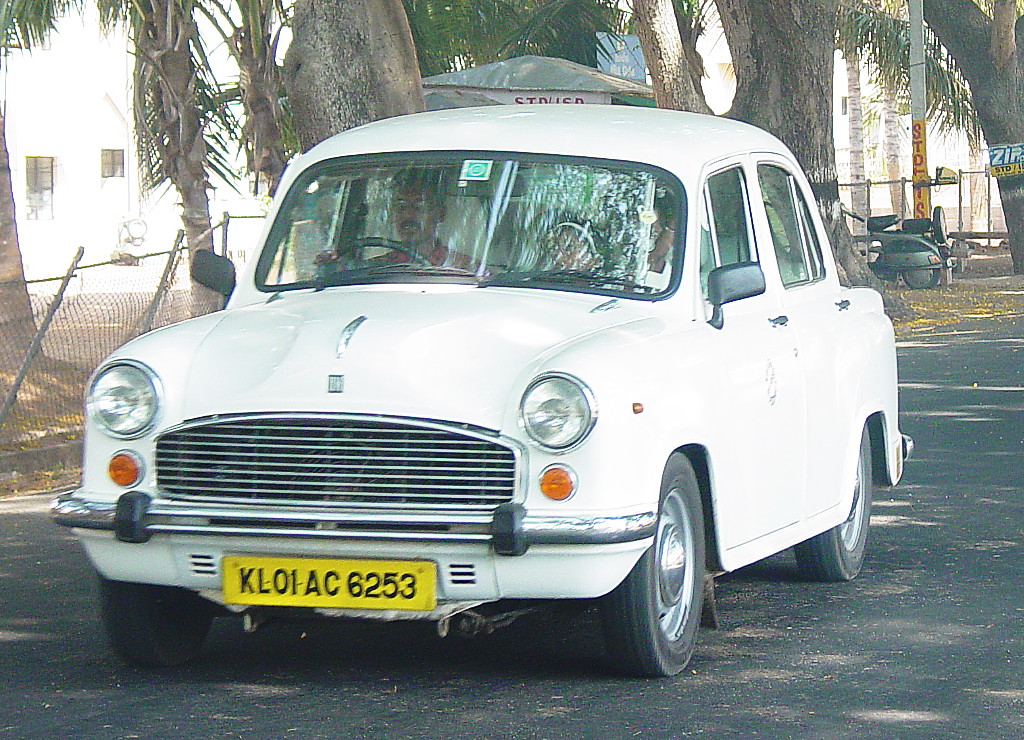 In 2004, the roads were passable though crowded, especially in Mumbai and other big cities. Outlying roads and some city streets were liberally pot-holed. We saw no evidence of repair going on, anywhere.
In 2004, the roads were passable though crowded, especially in Mumbai and other big cities. Outlying roads and some city streets were liberally pot-holed. We saw no evidence of repair going on, anywhere.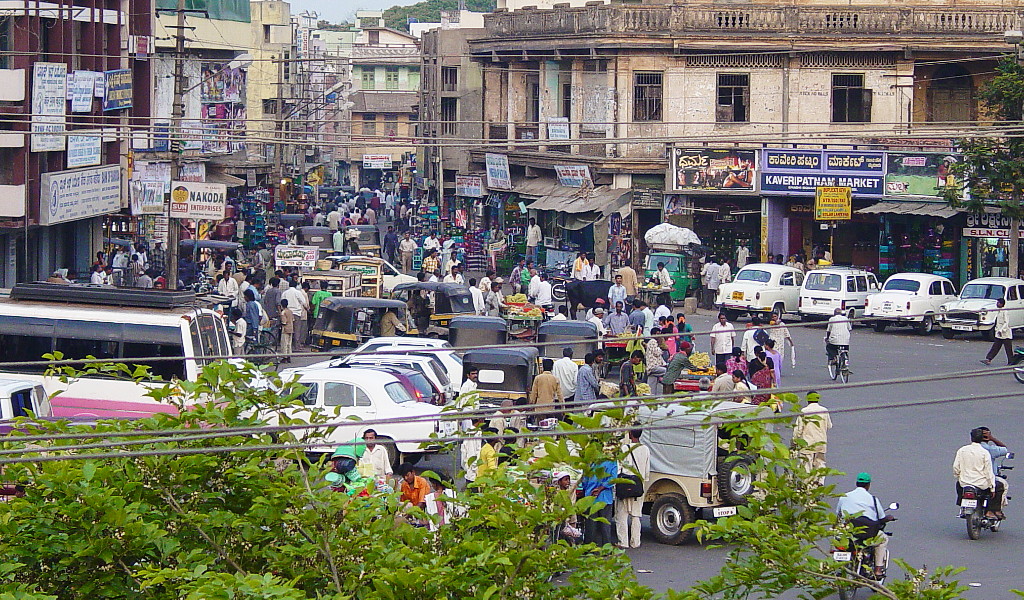 The joke, or really the sad thing, is that the entrance to this “super highway” in Varanasi is a severely deteriorated and potholed dirt path. You bounce and bang up to the edge of the highway, look both ways, and then quickly squeeze your way into the traffic accelerating as best as you can passing the bicycles, scooters, and walkers on the edge of the lane. It seems there was not enough money left over for creating a proper entranceway. Did it go into the pockets of a politician, a supplier, a constructor? Probably all three. Or maybe Varanasi just didn’t pay off enough politicians to make it happen. Whatever happened, it is hard to get on or off the highway in Varanasi. All this says nothing about the potholed street you must endure to get to the highway from the city of Varanasi.
The joke, or really the sad thing, is that the entrance to this “super highway” in Varanasi is a severely deteriorated and potholed dirt path. You bounce and bang up to the edge of the highway, look both ways, and then quickly squeeze your way into the traffic accelerating as best as you can passing the bicycles, scooters, and walkers on the edge of the lane. It seems there was not enough money left over for creating a proper entranceway. Did it go into the pockets of a politician, a supplier, a constructor? Probably all three. Or maybe Varanasi just didn’t pay off enough politicians to make it happen. Whatever happened, it is hard to get on or off the highway in Varanasi. All this says nothing about the potholed street you must endure to get to the highway from the city of Varanasi.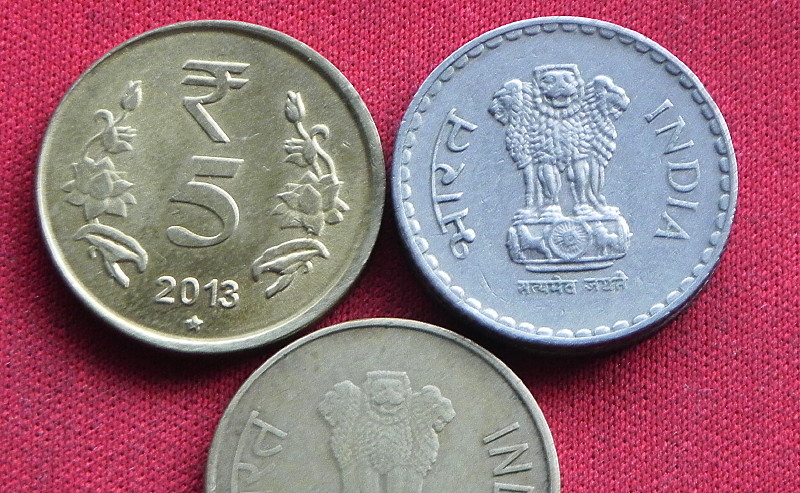 We did not want to say “no” to so many kids. We knew that most worked in gangs and didn’t get to keep much of what they got anyway. I have never liked to say “no,” though I have done so for many years. Petra added that there is enough negativity in the world in general and in the lives of those kids in particular. How could we get around our dilemma?
We did not want to say “no” to so many kids. We knew that most worked in gangs and didn’t get to keep much of what they got anyway. I have never liked to say “no,” though I have done so for many years. Petra added that there is enough negativity in the world in general and in the lives of those kids in particular. How could we get around our dilemma? 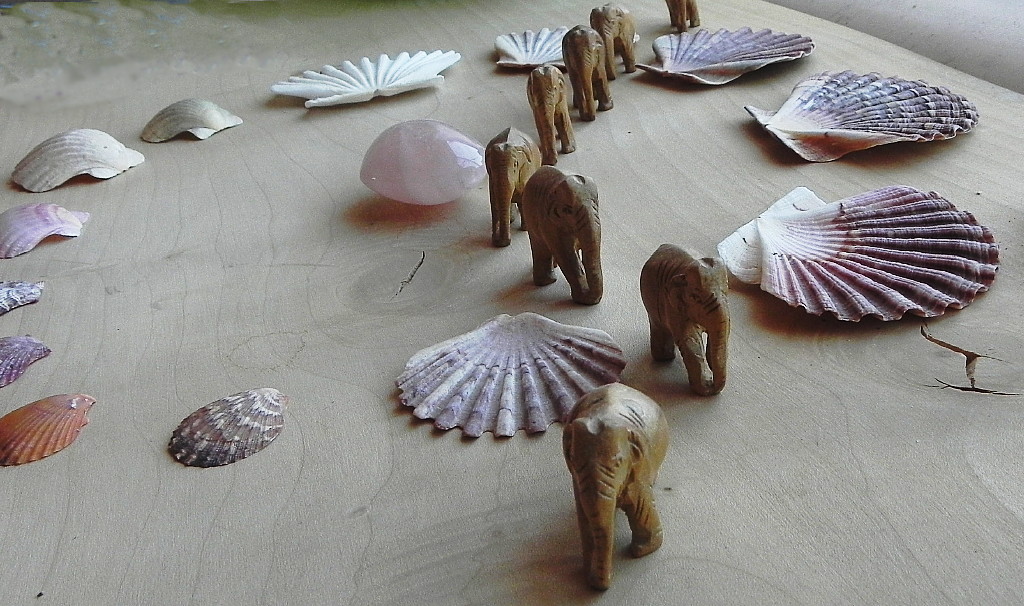 Late into the task, Petra was sitting in a vendor’s chair in a kiosk as the vendor was out trying to round up some Ganeshas. Customers were actually coming up and asking her for this or that. She was having fun playing the merchant. As she was doing that, the map salesman from a couple months ago (see above) came along with his maps and looked startled at Petra. He thought she was actually running a kiosk.
Late into the task, Petra was sitting in a vendor’s chair in a kiosk as the vendor was out trying to round up some Ganeshas. Customers were actually coming up and asking her for this or that. She was having fun playing the merchant. As she was doing that, the map salesman from a couple months ago (see above) came along with his maps and looked startled at Petra. He thought she was actually running a kiosk.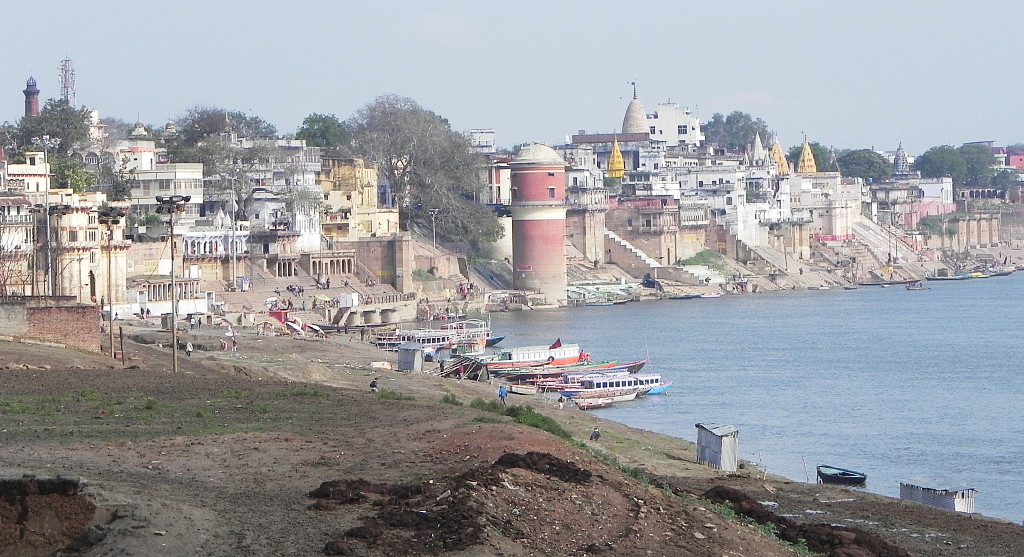 The Ganges River banks are a series of ghats, steps down to the river where people can congregate, relax, worship, and do many other activities. We walked south from ghat to ghat in the direction of our ashram at Nagar Ghat at the south end. Normally the ghats are busy places with many people but the rains allowed us to walk pretty much alone. In time, we happened on the main cremation ghat, a busy place even in the rain. Several fires were cremating the dead. The Hindus believe that if you die here and are cremated and your ashes are put into the Ganges, you go directly to the Promised Land and break the string of rebirths you have been going through. Before I arrived in Varanasi, I had heard about the Varanasi ghats and thought they all were for cremation. In fact, there are only two cremation ghats.
The Ganges River banks are a series of ghats, steps down to the river where people can congregate, relax, worship, and do many other activities. We walked south from ghat to ghat in the direction of our ashram at Nagar Ghat at the south end. Normally the ghats are busy places with many people but the rains allowed us to walk pretty much alone. In time, we happened on the main cremation ghat, a busy place even in the rain. Several fires were cremating the dead. The Hindus believe that if you die here and are cremated and your ashes are put into the Ganges, you go directly to the Promised Land and break the string of rebirths you have been going through. Before I arrived in Varanasi, I had heard about the Varanasi ghats and thought they all were for cremation. In fact, there are only two cremation ghats.  What is Auroville? Auroville is a place that “wants to be a universal town where men and women of all countries are able to live in peace and progressive harmony above all creeds, all politics and all nationalities. The purpose of Auroville is to realize human unity.” They so state on the opening of their web site at
What is Auroville? Auroville is a place that “wants to be a universal town where men and women of all countries are able to live in peace and progressive harmony above all creeds, all politics and all nationalities. The purpose of Auroville is to realize human unity.” They so state on the opening of their web site at